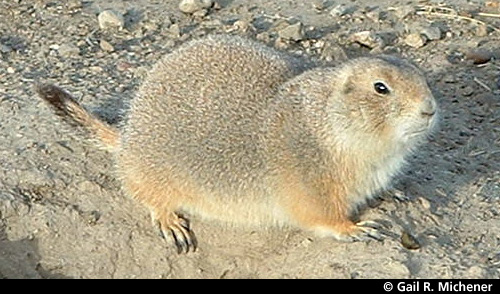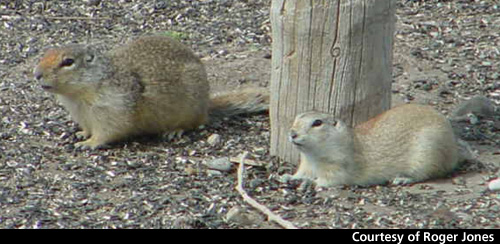Ground squirrels are medium-sized burrowing terrestrial squirrels. All ground squirrels in North America were grouped into the genus Spermophilus, along with European and Asian species. However, since April 2009 the North American species have been reorganized into six other genera (Urocitellus, Poliocitellus, Otospermophilus, Callospermophilus, Xerospermophilus, and Ictidomys). Other burrowing terrestrial squirrels are prairie dogs (Cynomys), antelope squirrels (Ammospermophilus), and marmots (Marmota).
The taxonomic revision by Helgen at al. (2009) recognizes 26 species of North America ground squirrels. Of these, the six species found in Canada are the Arctic ground squirrel, Columbian ground squirrel, Franklin’s ground squirrel, golden-mantled ground squirrel, Richardson’s ground squirrel, and thirteen-lined ground squirrel.
The ground-dwelling species with the most similar appearance to Richardson’s ground squirrels are the Wyoming ground squirrel (Urocitellus elegans) and the black-tailed prairie dog (Cynomys ludovicianus).
In the pet trade, Richardson’s ground squirrels and black-tailed prairie dogs are often confused with each other. Some pet dealers, either deliberately or out of ignorance, tell customers that they are buying a black-tailed prairie dog when in fact the animal is a Richardson’s ground squirrel. Before purchasing a pet, make sure that the seller knows how to distinguish between the two species and can confirm which species you are acquiring.
In nature, areas where both Richardson’s ground squirrels and black-tailed prairie dogs co-occur geographically are in and around Grasslands National Park in Saskatchewan, Canada, and north of the Yellowstone River in Montana, USA.
Wyoming ground squirrel (Urocitellus elegans)
The similarity in appearance between Wyoming ground squirrels and Richardson’s ground squirrels is so great that for many years the Wyoming ground squirrel was considered to be a subspecies of the Richardson’s ground squirrel. However, genetic evidence, including a difference in numbers of chromosomes, justifies classification as a separate species. The Wyoming ground squirrel occurs in three distinct non-contiguous locations in the US, primarily in Montana/Idaho, Wyoming/Colorado, and Nevada.
Black-tailed prairie dog (Cynomys ludovicianus)

Black-tailed prairie dogs are almost twice the size of Richardson’s ground squirrels, with a chunkier body, heavier limbs, and broader face. Relative to body size, the tail of black-tailed prairie dogs is much shorter and more conspicuously tipped with black than the tail of Richardson’s ground squirrels. When they stand up, black-tailed prairie dogs appear to tilt slightly backwards, whereas Richardson’s ground squirrels appear upright.
Black-tailed prairie dogs do not hibernate at all in the southerly parts of their geographic range though they do hibernate intermittently at northerly locations. In contrast, Richardson’s ground squirrels are obligate hibernators, with all individuals spending 4-8 months a year in hibernation.
Black-tailed prairie dogs live in complex family units called coteries which communally defend a common territory and burrow system. Although Richardson’s ground squirrels are gregarious and female kin form long-term amicable bonds, each adult has its own home range and burrow system.
Black-tailed prairie dogs construct large volcano-like mounds, and they use the snout to pack the soil above the entrance, leaving conspicuous nose imprints. Richardson’s ground squirrels simply discard excavated soil into a loose mound.
For more information (in Spanish) on the difference between Richardson’s ground squirrels and black-tailed priarie dogs see http://www.perritodelapradera.info/
Columbian ground squirrel (Urocitellus columbianus)

Columbian ground squirrel (on left) and Richardson’s ground squirrel.
Photo courtesy of Roger Jones
The geographic ranges of Richardson’s ground squirrels and Columbian ground squirrels overlap in the foothills of the Rocky Mountains, so both species are sometimes seen in proximity. Columbian ground squirrels are about 50% larger than Richardson’s ground squirrels and they have more colourful pelage, with flecked fur and a rufous snout.
Northern pocket gopher (Thomomys talpoides)
Northern pocket gophers are members of the rodent family Geomyidae, so they are only distantly related to ground squirrels in the rodent family Sciuridae. However, terminological confusion arises because many species of ground squirrels are colloquially called gophers even though they are not true gophers. In those regions where ground squirrels are called gophers, the true pocket gophers are often colloquially called moles – just adding further to the confusion because true moles are not even rodents; instead true moles are members of the mammalian order Insectivora (referring to their diet of insects and other invertebrates).
Related Pages:
Species Description
Evolutionary History
